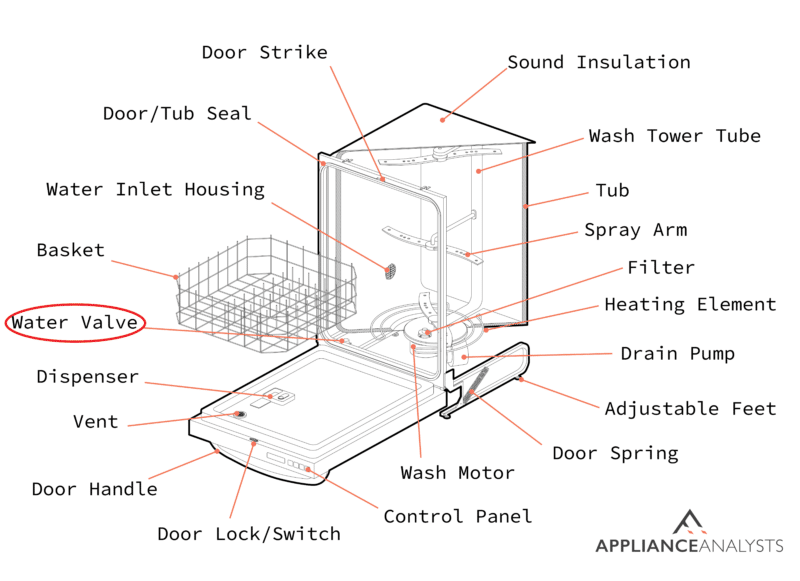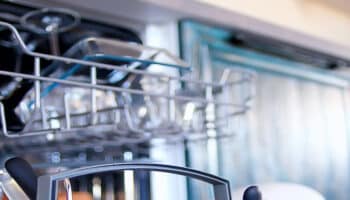We've independently reviewed this article to make sure it's as accurate as we can make it.
To find out more about our article creation and review process, check out our editorial guidelines.
Is your dishwasher not starting?
You’re not alone! I know how annoying it can be when your dishwasher stops working, especially when you have a pile of dirty dishes.
The good news is that you’ve come to the right place for answers.
If your dishwasher is not starting, there’s a good chance the circuit breaker has tripped, the child lock is enabled, or there’s something wrong with the door latch. A faulty water valve or control board can also explain the issue.
Keep reading to get sparkling clean dishes today!
Why trust us? This article was written in collaboration with two appliance repair experts: James Blackford & Andy Fulencheck. We have over 25 years of combined appliance repair experience – please see our profiles to learn more about our backgrounds.
8 Fixes for a Dishwasher That Won’t Start
One of the most common issues I encounter in my appliance repair work is a non-responsive dishwasher that simply won’t start.
This problem can happen due to numerous reasons. The good news is that there are multiple solutions you can try. These are:
#1 Go to the Circuit Breaker
I first recommend making sure your dishwasher is plugged into the wall outlet.
I know this may sound like a simple fix, but dishwashers can get accidentally unplugged without us noticing. In fact, this can easily explain why your dishwasher in not starting.
However, if that’s not the case, please try turning on your garbage disposal.
Let me explain: Dishwashers and garbage disposals typically share the same circuit. So, if your garbage disposal isn’t starting either, there’s a good chance the circuit breaker tripped.
In that case, you’ll need to go to the circuit breaker and turn it on.
Please note that not all dishwashers and garbage disposals share the same circuit. This may vary depending on your home’s electrical setup.

If the switch was already in the “on” position, please turn it off and back on. Doing this will reset the breaker and can get things back to normal.
#2 Disable the Child Lock
Most dishwashers have a child lock feature that prevents children from accidentally changing the settings and getting hurt.
So, if you try to select a cycle on your dishwasher, but it’s not starting, and nothing is happening, there’s a good chance the child lock is turned on.
Try turning it off by pressing the padlock or key button for 3 to 6 seconds.
#3 Check Your Connections
In my experience, when a dishwasher is not turning on, the wires are likely damaged.
To check the wires, you’ll need to turn off the breaker connected to your dishwasher and unscrew the access panel to access the junction box (typically a grey box).
Then, check the connections where the wires of your house meet the wires of your dishwasher. If they are burnt, you’ll need to remove the old cap, clean up the wire, and put it back together.
If you notice that the wire is crispy, I recommend trimming it back a bit before applying the new cap.
#4 Inspect the Door Latch
One of the most common reasons your dishwasher won’t start is that there is something wrong with the door latch assembly. This includes the door lock switches.
You see, the door latch is responsible for keeping the door closed during operation. If it’s damaged, your dishwasher will think the door is not closed and won’t turn on.
Here’s how to solve a faulty door latch.:
Before we get started on a lengthy fix, make sure that the door is closing fully, and not obstructed by cabinets, dishes, dirt, food, etc.
- Unplug your dishwasher or turn off the circuit breaker.
- Take a look at the top of your dishwasher door. In some models, you need to remove the inner door panel to locate the assembly system. I recommend using the tech sheet to help you (you can often find this online for your model).
- After you find the door latch assembly, ensure it properly activates the switches. To do this, insert the door catch into the assembly. If it does not activate, then you need to replace the door latch system.
- You also want to use a multimeter to test the continuity of the door latch system. If you get a reading that is 0, then it is time to replace it.
Here’s a good walkthrough video to help you replace your dishwasher’s door latch:
Replacing the door latch assembly is very simple and usually quite inexpensive. Some models even allow for replacing an inexpensive micro-switch vs the entire assembly. Please keep in mind that you need to refer to the manufacturer’s manual to replace the door latch.
#5 Check the Water Valve
Unfortunately, if your dishwasher is still not starting, there’s a good chance you have a faulty water valve.
You see, when you close your dishwasher’s door and select a cycle, the control board will instruct the water valve to open and allow water to enter your dishwasher.
So, if the water valve is not working, your dishwasher will not fill with water and won’t start.
Sometimes accessing the water valve can be a bit challenging, so I recommend referring to the owner’s manual for detailed instructions.
Replacing the water valve is very simple and inexpensive, as its cost range from $20 to $60.

#6 Test the Control Board
Unfortunately, if there’s something wrong with the control board, your dishwasher won’t turn on or is not going to start the washing cycle.
You see, a control board is responsible for coordinating different functions. It sends voltage to different components of your dishwasher, such as the water valve, heating element, drain pump, etc. This way, they can start their operation.
To check if the control board is the culprit, please test it for continuity with a multimeter.
Just keep in mind that with some dishwashers, accessing the control board is very challenging, so I recommend searching for videos online or referring to your manual. If you don’t feel comfortable doing this yourself, please call a professional.
If the control board needs replacement, I recommend comparing the cost of the component with the price of getting a new dishwasher. Control boards can be quite expensive, ranging from $80 to $300!
#7 Fix the Selector Switch / User Interface
The selector switch in your dishwasher allows you to control different operating modes. So, if it’s not working, your dishwasher won’t start.
First, I recommend taking a look at the buttons and making sure none of them have gotten stuck after being pressed down.
But, if there are no buttons that are permanently stuck, please follow these simple instructions:
- Unplug your dishwasher from its power source and remove the inner door panel. This is commonly where the selector switch is located.
- Take a look at the selector switch and make sure it is in the correct position, comparing it to the owner’s manual. If it is not, you need to remove it from your dishwasher.
- Use your multimeter to test the continuity of the selector switch. Make sure you are getting an appropriate reading by comparing the reading to your owner’s manual.
- Depending on the type of dishwasher you have, you’ll need to test multiple parts of the selector switch.
- If you are not getting the appropriate readings, please replace the selector switch.
As always, you need to think about the cost of replacing the selector switch. Make sure it is worth it when compared to the price of replacing your dishwasher.
#8 Test the Thermal Fuse
The thermal fuse is an important safety component of your dishwasher, as it cuts the power to the control panel if it senses that your dishwasher is overheating.
It will also cut the power to your dishwasher if there is a short circuit in the wire. So, if the thermal fuse blows, it will prevent your dishwasher from starting.
There are two reasons why your thermal fuse may not be working correctly. The first reason is a blown thermal fuse, which has occurred at some point in the past. As a result, your dishwasher won’t start.
Alternatively, your thermal fuse is working perfectly, but your dishwasher is not reading it correctly and refusing to start. To solve this issue, look inside the dishwasher’s door panel where the thermal fuse is located.
If the thermal fuse has been blown, some designs will allow you to observe this visually. However, if the thermal fuse appears intact, you need to test the continuity to make sure it has a continuous electrical path.
If you have confirmed that your thermal fuse is blown, then you need to replace it. While the fuse itself is inexpensive, the reason the thermal fuse has blown is typically more expensive.
A blown thermal fuse is a signal of a larger issue, which has caused your dishwasher to get too hot. So while repairing a thermal fuse can be quite cheap, finding and repairing the underlying issue can be more difficult.
Conclusion
Ultimately, these are just a few of the many reasons why your dishwasher is not starting.
Some of these reasons your dishwasher won’t start are relatively straightforward, such as making sure your appliance is plugged in, and ensuring the circuit breaker is behaving properly. Other reasons can require you to replace a part of your dishwasher, such as the door latch system.
Remember to reach out to a professional if you are uncomfortable at any point.
Thank you so much for reading! Don’t forget to check out our dishwasher maintenance guide to make the most out of your appliance.
Good luck!









